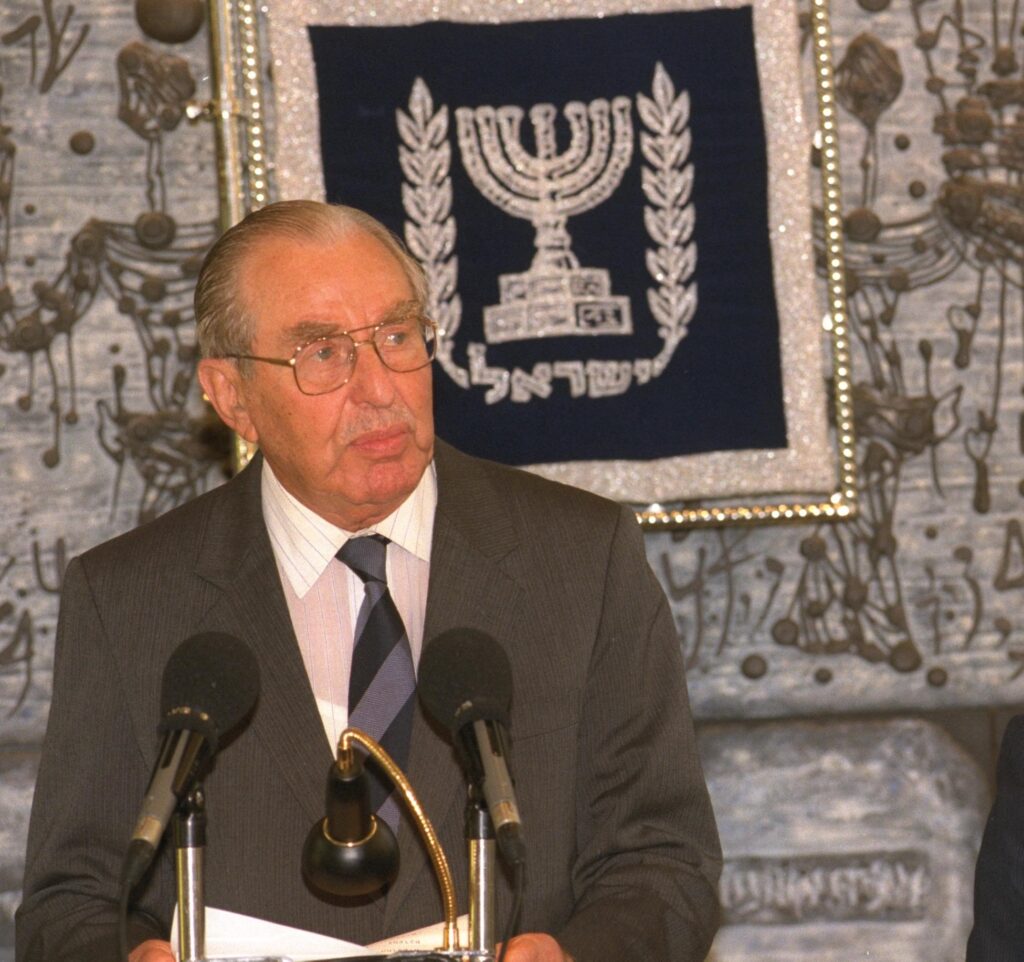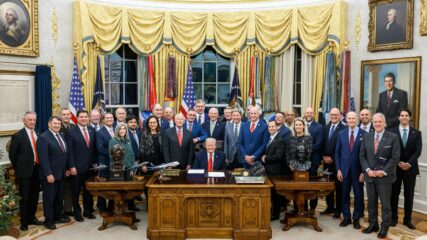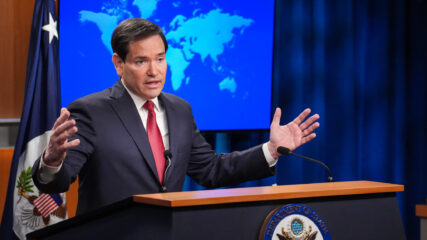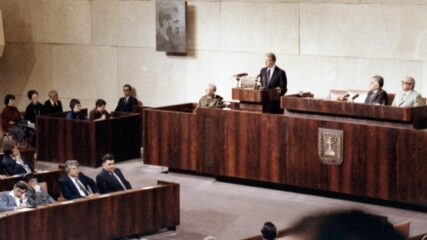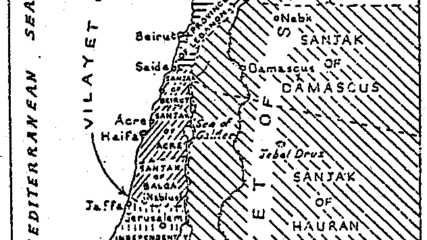Eytan Bentsur, a member of the Israeli delegation at Madrid who became director-general of the Foreign Ministry, wrote a decade after the peace conference that President George H.W. Bush’s speech opening the conference laid out the principles for the entire negotiating process: direct negotiations including land for peace; bilateral and multilateral talks; solutions coming from within the region, not imposed from outside; self-determination for the Palestinians and security for the Israelis; and a result of peace treaties providing true normalization, including diplomatic, economic and cultural relations.
But the optimism of the conference’s opening has slammed into harsh reality at the end of the three days of speeches.
Prime Minister Yitzhak Shamir takes most of the Israeli delegation home immediately after his speech to open the plenary session Nov. 1. It is Friday, and they want to be back in Israel before Shabbat. But Shamir is not known as an observant Jew — he doesn’t wear a kippah in public — and it is common for Israeli officials abroad to make local arrangements for Shabbat. The leaders of several Arab delegations criticize Shamir’s departure, as Bentsur does in his 2001 memoir, “Making Peace”: “I felt that they were treating the Madrid Conference as a trivial affair, not one that was laying a cornerstone for a peace process that, however arduous, tiresome, and risk filled, might promise Israel its yearned-for peace.”
Immediately after the conference, Israel and its Arab neighbors disagree about where to begin the promised bilateral peace talks. Israel invites everyone to meet in Israel, keeping all parties close to their governments and away from the potential pressure of outside parties. Soviet Foreign Minister Boris Pankin makes the argument in his closing speech that everyone is in Madrid, so the best way to keep the peaceful momentum going is in Madrid.
The four sets of bilateral talks — Israel-Jordan, Israel-Lebanon, Israel-Syria and Israel-Palestinians — do begin Nov. 3 in Madrid, then move to Washington. Twelve rounds of talks are held in Washington, the first Dec. 9, 1991, and the last Jan. 24, 1994. The confidence-building measures Secretary of State James A. Baker III promotes before and during the Madrid conference, such as an Israeli settlement freeze and an end to the Arab boycott of Israel, don’t happen.
The bilateral talks gain momentum Labor leader Yitzhak Rabin wins election as prime minister in June 1992, replacing Shamir, but the Madrid process loses its strongest U.S. advocate when Baker resigns as secretary of state to head Bush’s unsuccessful re- election campaign in August 1992. President Bill Clinton is less focused on the Middle East when he takes office in January 1993. The Soviet Union, meanwhile, breaks apart in December 1991, but the parallel if less emphasized multilateral talks on regional issues convene in Moscow January 1992 and organize five forums for May meetings: water in Vienna; the environment in Tokyo; arms control in Washington; economic development in Brussels; and refugees in Ottawa. The groups gather intermittently in cities around the world through November 1993.
Syria and Lebanon refuse to attend the multilateral meetings because of the lack of progress in their bilateral talks with Israel. Israel skips the groups on refugees and economic development because of the participation of Palestinians who don’t live in Gaza or the West Bank.
The multilateral steering committee comes together again in Moscow in January 2000 with the goal of relaunching the regional meetings, but nothing results.
Document: Bush remarks at a Texas fundraiser, Nov. 1, 1991
Significance: President George H.W. Bush puts the burden on the Middle Eastern parties to negotiate solutions with the help of Secretary of State James A. Baker III. Bush himself is moving on. At his first post-Madrid press conference Nov. 6, he says nothing about the Middle East or the peace conference, and none of the reporters asks him about the new peace process.
Excerpt: “We were able to bring warring factions together, as Phil (Gramm) said, people who have been at war for thousands of years to at least talk, to come together under the same roof in Madrid and to begin to at least talk about peace. I don’t know what’s going to happen in that. I don’t know how successful we’re going to be. But it was success to just bring those parties together.”
Document: Post-Madrid reactions compiled by the United Nations, November 1991
Note: The U.N. Division for Palestinian Rights’ monthly compilation of statements and documents for the Committee on the Exercise of the Inalienable Rights of the Palestinian People focuses almost exclusively on responses to the Madrid conference in November 1991. What do the names of the two organizations involved in this compilation say about their motivations?
U.N. Secretary-General Javier Perez de Cuellar, Nov. 5, 1991: “Madrid proved that dialogue is possible. … Arab states should change their systematic anti- Israel rhetoric.” PLO Chairman Yasser Arafat, Nov. 9, 1991: “When the voice of our people resounded in Madrid through their delegation, which enjoys their trust and that of their leadership — the PLO — the world listened to the voice of more than 6 million Palestinians in the homeland, in the exiles and in the diaspora and also listened to the epic of the bitter suffering, the firm steadfastness, the brave resistance and the just struggle. Our participation in the Middle East peace conference … came as a result of a sound understanding and an accurate assessment of the changes in our world and as a result of the desire and commitment for protecting the higher national interests of our people as well as the higher pan-Arab interests.”
Egyptian Foreign Minister Amre Moussa, interview with Al-Sharq Al-Awsat, Nov. 14, 1991: “If some use the argument of peace in return for peace, then we would take the matter to its origin and say rights in return for rights, commitment for commitment, and security for security. … I believe that Israel has now joined the peace process and that the international community will not allow it or anyone else not to be serious about it.”
Israeli Prime Minister Yitzhak Shamir, statement upon return from a U.S. visit, Nov. 24, 1991: “Our neighbors, however, refuse to talk directly to us, even on the technical issue of the venue for the talks; instead, they appeal to the United States. That behavior does not show a readiness to conduct direct, genuine, free negotiations. … It appears that the intention of the Arab side, to our regret, is not to negotiate with us, but to talk with the U.S. administration so that the United States will impose on us the Arab positions, which are unacceptable to us.”
Ehud Gol, Shamir adviser, on the agreement to continue bilateral talks in Washington, Nov. 27, 1991: “The proposal to hold the three meetings simultaneously in Washington will gather all the Arab delegations in one place. Experience has shown that in such a situation the lowest common denominator decreases, extremism takes over, and the chances for real negotiations become minimal.”
Jordan’s King Hussein, interview with London-based TV reporter, Nov. 29, 1991: “Madrid, I believe, provided an opportunity to the brothers and sons of Palestine … to appear before the world in an appropriate manner, which they had been denied for a long time, and to communicate … as a people who strive to save their rights on their territory and national soil. I believe that their performance was excellent.”
Significance: The Palestinians are thrilled to be at the negotiating table with Israel, and their Jordanian and Egyptian supporters are counting on continuing international pressure. Israel, on the other hand, is pessimistic, fearing that bilateral talks in Washington will operate like multilateral negotiations and stifle progress.
One quick benefit of the Madrid negotiations is that the U.N. General Assembly votes in December 1991 to revoke its notorious 1975 Resolution 3379, which equated Zionism with racism. The revocation of Resolution 3379 is a goal Baker stated in his 1989 speech to AIPAC and the United States offered in its pre-Madrid letter of assurance to Israel.
Document: President Chaim Herzog on the revocation of U.N. Resolution 3379, Dec. 16, 1991
Excerpt: “Above all, by annulling the resolution, the United Nations has now removed a shameful blot upon its good name and repute.”
Significance: The Soviet Union and the PLO drove the 1975 resolution’s passage when Herzog was Israel’s ambassador to the United Nations. Twenty-five states vote against repealing 3379, including peace conference participants Jordan, Lebanon and Syria, as well as Libya, Iran, Iraq, Qatar, Saudi Arabia, Sudan, United Arab Emirates and Yemen.
Ultimately, the parties themselves circumvent the Israeli-Jordanian and Israeli-Palestinian tracks established at Madrid. Frustrated by the Palestinian delegation’s inability to move forward in Washington without PLO leader Yasser Arafat’s approval, the Israelis secretly negotiate directly with the PLO in Norway, culminating in the signing of the Declaration of Principles on Sept. 13, 1993.
Document: Oslo Accords, Sept. 13, 1993
Excerpt: “The aim of the Israeli-Palestinian negotiations within the current Middle East peace process is, among other things, to establish a Palestinian Interim Self-Government Authority, the elected Council, (the ‘Council’) for the Palestinian people in the West Bank and the Gaza Strip, for a transitional period not exceeding five years, leading to a permanent settlement based on Security Council Resolutions 242 and 338.”
Significance: Israel and the PLO officially recognize each other and agree to a phased approach to Palestinian elections and autonomy during a period of negotiations to resolve final-status issues, such as borders, water and Jerusalem. The Oslo agreement is not the comprehensive resolution of the Israeli-Arab conflict envisioned at Madrid, but it is similar to what Baker presented to AIPAC in May 1989.
With the Oslo Accords in place, King Hussein and Israel also move forward outside the Madrid framework, holding direct talks that produce a peace treaty in October 1994.
Document: Israel-Jordan Peace Treaty, Oct. 26, 1994
Excerpt: “Both Parties, acknowledging that mutual understanding and cooperation in security-related matters will form a significant part of their relations and will further enhance the security of the region, take upon themselves to base their security relations on mutual trust, advancement of joint interests and cooperation, and to aim towards a regional framework of partnership in peace.”
Significance: Israel now has secured peace with two of the four states it touches: Egypt, the strongest of the Arab states, and Jordan, which has the longest border with Israel. But like the cold peace with Egypt, Israel’s treaty with Jordan fails to produce the full benefits of normal relations, at least in part because of the continuing uncertainty about the Palestinians’ future.
The Oslo Accords bring Arafat and the PLO leadership back from exile to establish a government based in Ramallah in the West Bank. The new Palestinian Authority gains autonomy in Gaza and the most populated Arab areas of the West Bank and establishes security cooperation with Israel. But despite signing a second agreement to advance the Oslo process in September 1995, Israel and the PA struggle to resolve final-status issues amid extremist opposition on both sides, including Hamas terrorism. An Israeli Jewish extremist assassinates Rabin in November 1995, and a leading critic of the Oslo process, Benjamin Netanyahu, defeats peace advocate Shimon Peres for prime minister in 1996.
Netanyahu and Arafat recommit to the Oslo process by signing the Wye River Memorandum in October 1998, past the five-year deadline included in the 1993 Oslo agreement to resolve the remaining issues. Clinton hosts the negotiations and mediates the agreement as he commits to working toward a final Israeli-Palelstinian accord during his second term. Labor’s Ehud Barak succeeds Netanyahu as prime minister in 1999. Clinton brings Barak and Arafat to Camp David in July 2000. But Arafat refuses to accept or counter Barak’s last, best offer. Instead, Arafat in October 2000 supports the outbreak of the Second Intifada, in which thousands of Palestinians and Israelis are killed in almost five years of suicide bombings and military attacks in Gaza and the West Bank. Facing the end of his term in January 2001, Clinton issues a framework for a peace settlement in December 2000 after separate U.S. talks with Israel and the Palestinians. Israel says yes with reservations to be negotiated; Arafat talks a lot during the remainder of the Clinton administration but never says yes or no.
Document: Clinton Parameters, Dec. 23, 2000
Excerpt: “I believe that the solution should be in the mid-90 percents, between 94-96 percent of the West Bank territory of the Palestinian State. The land annexed by Israel should be compensated by a land swap of 1-3 percent in addition to territorial arrangements such as a permanent safe passage. The parties also should consider the swap of leased land to meet their respective needs.”
Significance: As Clinton writes in his memoirs, Arab leaders elsewhere in the Middle East are impressed that Israel is willing to make a deal based on the U.S. outline, and, from the Palestinian perspective, “the deal was so good I couldn’t believe anyone would be foolish enough to let it go.” But Arafat is unwilling to risk his reputation and perhaps his life by making a deal that reflects any compromise.
Explore the Timeline of the Arab-Israeli Conflict from 1993 to Present.
- Why weren’t negotiations in 1991 successful and why did a peace agreement emerge with Jordan in 1994? Could the success or failure of talks have been foreseen? Regardless, how did the 1991 negotiations move the peace process forward? What makes negotiations significant even when they meet with failure? What made these talks a turning point in history and how did they set the stage for future negotiations?
- Direct Talks vs. Multilateralism and Mediation: What role did the U.S. play and why? How did both sides view the American mediation and what challenges did this model face?
- The wider Middle East context: Egypt and Jordan were able to negotiate peace with Israel without a resolution vis a vis the Palestinians. In the Abraham Accordds of 2020, four more Arab countries in the region signed agreements with Israel without conditioning a resolution to the Palestinian-Israeli conflict. Does this strengthen or weaken the Palestinian negotiating position? How could this impact the future of negotiations with the Palestinians?
- Compare and contrast the U.S. position toward the conflict in 1991 and today (https://israeled.org/themes/united-states-and-israel/). What does this mean for U.S. Israel relations and policy decision making?
- Consider the implications of today’s resolved and unresolved issues, which include return of refugees, Jerusalem, security, economy, Hamas, Iran as a threat, settlements and construction, water, land contiguity, recognition of Israel as a Jewish state, international monitoring, and “Quartet” and Arab support. How much of these have previously been addressed in prior negotiations and what remains to be resolved? Are current parties interested in resolution with compromises or in maintaining the status quo until conditions are more favorable?
- How do the Abraham Accords mark a turning point for Israel’s relationships with the Arab world? What made those negotiations successful? Now consider the May 2021 conflict in the context of previous negotiations. How do mediators (including Egypt) and the wider Middle East context inform the conflict? Watch the following video: https://israeled.org/the- palestinian-israeli-clashes-may-2021/ and explore timely readings here: https://israeled.org/99-contemporary-readings-may- 2021/

